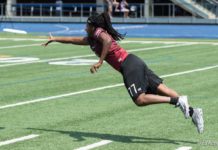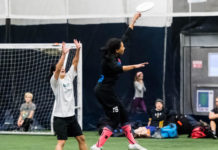Ultimate Canada Magazine – November 30, 2017
Written by: Mike Haddock
So you just finished a long Ultimate season, what now?!
With a positive season behind you, you are eager to keep building momentum and work to become stronger, faster and more explosive. However, if your season didn’t quite live up to expectations, you are also realizing you need to do more work to achieve your goals. Either way, almost all Ultimate athletes are transitioning to offseason development and training.
As a Strength and Conditioning Coach, my athletes and I sit down at the beginning of the offseason and make sure we are on the same page for our offseason goals. They likely have the same aspirations that were discussed above, and I might also have a few goals for them; such as fixing that ‘cranky knee’, or dealing with the ankle sprain that occurred in August. Once we know our goals for the next 8 months, it is my job to figure out ‘Where’ you need to improve and ‘How’ you are going to do it. In order to begin answering these complex questions, we have to start with ‘Assess & Test.’
Regardless of whether you are new to training or you have an ‘advanced training age’, we need to look at both quantitative and qualitative abilities.
Quantitative: these are ‘measurable’ items, like Sprinting Speed, Jump Height, and Change of Direction test. Some of my favourites are:
- 10m Acceleration Sprint Test – this is a perfect test to measure your acceleration in small spaces (like handler cuts).
- 40m Top Speed Sprint Test – this test measures the time it takes for an athlete to cover 40 metres; which translates to an athletes’ overall top speed.
- How To-Do Yourself = measure out the distances (10m & 40m) with a measuring tape, and ask a friend to join you. Your training partner will give a ‘Ready-Set-Go’ and, using a stopwatch, will measure your time to cover the distance.
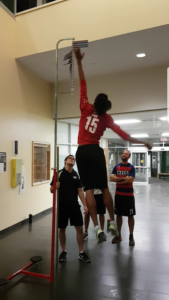
Jacky Hau, Toronto RUSH/GOAT Athlete, completing a Vertec Vertical Jump. Photo/Mike Haddock
- How To-Do Yourself = measure out the distances (10m & 40m) with a measuring tape, and ask a friend to join you. Your training partner will give a ‘Ready-Set-Go’ and, using a stopwatch, will measure your time to cover the distance.
- Vertical Jump – an all time favourite, vertical force is strongly correlated to all other performance skills like top speed, jump height, and acceleration.
- How To-Do Yourself = choose a wall with a large clear open vertical space. Standing next to the wall (and with your training partner standing on a chair/bench), measure your standing reach with your dominant hand. Once you are ready to jump, take a piece of masking tape and create a ‘loop’ and wrap it around your second and thirdfingers (sticky side outwards). As you jumped and reach the apex, slam your fingers into the wall and leave the tape behind. Use this score and subtract your Standing Reach to determine overall jump height.
Qualitative: Each and every athlete is built differently, but the mechanics of the human body are universal. It is critical that each athlete executes the basic human movements to a specific degree of control and consistency. Some of the questions that we ask of each athlete are:
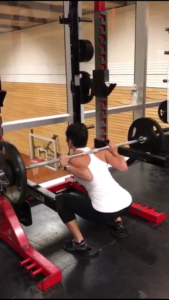
4. Squat Variation – does the athlete truly understand how to use the glutes (both in the descent, and as the primary contributor on the ascent)? Can they maintain control and balance during all phases of the movement? Is there a loss of rigidity in either of the spine or knee positions?
5. Hinge Variation – does the athlete understand how to coordinate this complex action? Can they maintain a rigid spine throughout the range? Do they regulate to the correct range?
6. Single Leg Variation – does the athlete have control throughout the motion (or struggle with balance)? Does the athlete habitually step into the correct foot width and length? Can they properly use the lower body musculature?
Remember, these are just some of the elements that we Assess & Test. As with any part of your training experience, you need to be asking “why?” – what is the point of this?
Our qualitative assessments tell us where you likely experiencing faulty mechanics and may be predictive of future injury risks. If you have ‘dysfunctional’ movements, then you are very likely to be wasting power and energy into directions that you don’t want and could end up in a position that is considered riskier. As for the Quantitative tests – how else will you know if you are performing better? Having baseline times and distances will tell you if the program is working and if you are truly translating your training into on-field results.
In closing, it is important to recognize that EVERY athlete needs to work on high quality mechanics that area executed consistently. This is true for an athlete new to training, right up to an elite international athlete.
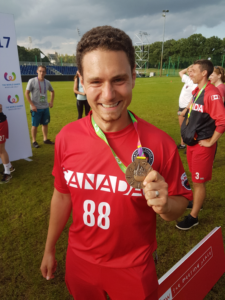
Mike Haddock is the owner of Haddock Sport Performance (HSP), and is the head Strength & Conditioning Coach for Ultimate Canada; overseeing the World Games (Bronze Med al) team & upcoming U24 & U20 Programs, as well as the Toronto RUSH/GOAT system. If you would like to learn more about HSP tips, technique, and work; follow HSP on Instagram.

![International Women’s Day 2019 [Presented by VC Ultimate]](/c/wp-content/uploads/2019/03/unnamed-218x150.jpg)
